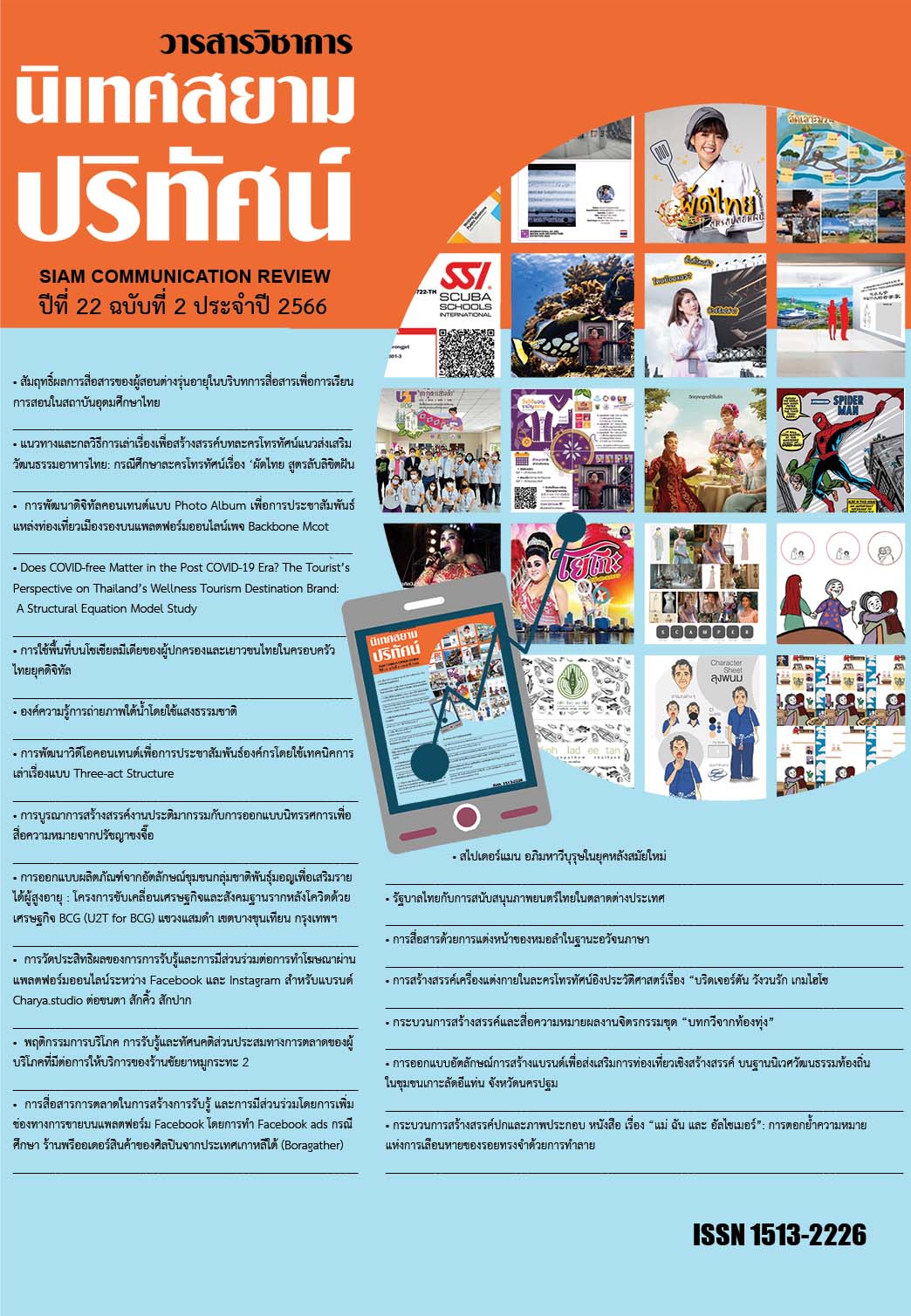Approaches and Narrative Techniques of TV Drama for Promoting Thai Cuisine Culture : A Case Study of ‘Pad Thai, The Secret Recipe’
Main Article Content
Abstract
This creative research aims to study approaches and narrative techniques for creating the TV drama script in order to promote Thai cuisine culture. This study was developed from research to expand awareness to wider society. Moreover, this study was analyzed the audience’s results to develop this project as the innovation of Thai TV drama script for supporting creative industries in the future.
The results of the study in terms of approach and narrative technique revealed that this TV drama script was narrated through a number of components such as plot, theme, conflict, character, point of view, setting and special symbol to narrate Pad Thai’s background story and diversity in three generations, World War II era, Transitional era, and Food Innovation era. All of the techniques were applied to time and place overlap by direct characters’ experiences, reminiscence and dream to represent social and cultural contexts and memorable events which leads this TV drama script to be a lived story.
The results of online platform audience analysis from 337 viewers were positive as following. Firstly, 32 percent of the audiences admired characters and actors as the most because they could convey the viewpoint of humanity in deeply details. Secondly, 20.5 percent of the audiences supported to produce qualified TV drama for Thai Cultural Promotion. Finally, 15.8 percent of the audiences expressed that this story made them appreciate and impress in the warm family.
Article Details

This work is licensed under a Creative Commons Attribution-NonCommercial-NoDerivatives 4.0 International License.
References
กระทรวงวัฒนธรรม. (2559). ร่างกรอบทิศทางยุทธศาสตร์ 20 ปีด้านวัฒนธรรมตามกรอบทิศทางยุทธศาสตร์ชาติระยะ 20 ปี. [ออนไลน์]. เข้าถึงได้จาก: https://www.m-culture.go.th/mculture_th60/download/article/article_20161115150015.pdf สืบค้นเมื่อ 25 พฤศจิกายน 2564.
กองทุนสื่อปลอดภัยและสร้างสรรค์. (2561). [ออนไลน์]. เข้าถึงได้จาก: http://www.thaimediafund.or.th/page/view/34/?p=1 สืบค้นเมื่อ 26 พฤศจิกายน 2564.
กาญจนา แก้วเทพ. (2553). แนวพินิจใหม่ในสื่อสารศึกษา. กรุงเทพมหานคร: ภาพพิมพ์.
กาญจนา แก้วเทพ. (2545). สื่อบันเทิง: อำนาจแห่งความไร้สาระ. กรุงเทพมหานคร:ออล อเบาท์ พริ้นท์.
คณะอนุกรรมาธิการขับเคลื่อนการปฏิรูปเศรษฐกิจกระแสใหม่ สภาขับเคลื่อนการปฏิรูปประเทศ. (2559). การ ปฏิรูปเศรษฐกิจกระแสใหม่. [ออนไลน์]. เข้าถึงได้จาก: https://www.nstda.or.th/th/news/5050-neweconomy สืบค้นเมื่อ 8 พฤษภาคม 2561.
จิตติมา คิ้มสุขศรี, สุเนตรชุตินธรานนท์ และสรรัตน์ จิรบวรวิสุทธิ์. (2562). นวัตกรรมละครโทรทัศน์เพื่อการส่งเสริมอุตสาหกรรมวัฒนธรรมไทย 4.0: กรณีศึกษา ‘ผัดไทย’. กรุงเทพมหานคร: ศูนย์พหุวัฒนธรรมกษาและนวัตกรรมทางสังคม สถาบันเอเชียศึกษา จุฬาลงกรณ์มหาวิทยาลัย.
จิรยุทธ์ สินธุพันธุ์. (2558). แสงศรัทธาเหนือลำน้ำเจ้าพระยา: ประวัติศาสตร์ ความทรงจำ และบทสนทนาทางการเมืองในปฏิบัติการสื่อสารการแสดง. วารสารนิเทศศาสตร์, 33,3 (กรกฎาคม-กันยายน 2558): 4.
ถิรนันท์ อนวัชศิริวงศ์ และคณะ. (2547). สุนทรียนิเทศศาสตร์ การสื่อสารการแสดงและสื่อจินตคดี. (พิมพ์ครั้ง ที่ 2). กรุงเทพมหานคร: โครงการสื่อสันติภาพ คณะนิเทศศาสตร์ จุฬาลงกรณ์มหาวิทยาลัย.
นิธิ เอียวศรีวงศ์. (2545). ว่าด้วยการเมืองของประวัติศาสตร์และความทรงจำ. กรุงเทพมหานคร : มติชน.
นิพัทธ์ชนก นาจพินิจ. (2565).พื้นที่อาหาร Food Space ผู้คน ชุมชน เมือง. [ออนไลน์]. เข้าถึงได้จาก:
https://www.tuda.or.th/index.php/2021/09/13/department-of-urban-and-regional-planning-discussion-paper สืบค้นเมื่อ 30 ตุลาคม 2566.
ปรัศนีย์ เกศะบุตร. (2554). การรณรงค์เรื่องการกินและการประกอบอาชีพขายก๋วยเตี๋ยวกับนโยบายสร้างชาติของรัฐบาลจอมพล ป. พิบูลสงครามใน พ.ศ.2485-2487. BU Academic Review.
ประยูร อุลุชาฎะ. (2545). อาหารรสวิเศษของคนโบราณ. กรุงเทพฯ: แสงแดด.
เมธี พิริยการนนท์ และนภดล ตั้งสกุล. (2564). ปริทัศน์บทความเรื่องพื้นที่สาธารณะ พื้นที่ทางวัฒนธรรม และ
พื้นที่สาธารณะทางวัฒนธรรม. [ออนไลน์]. เข้าถึงได้จาก: file:///C:/Users/Administrator/Downloads/252584-Article%20Text-901829-1-10-20210629%20(2).pdf สืบค้นเมื่อ 26 พฤศจิกายน 2564.
วธ.เดินตามรอยกิมจิ ชวนผู้จัดผลิตละครย้อนช่วง เอกลักษณ์ไทย. (2561). [ออนไลน์]. เข้าถึงได้จาก: https://www.thaipost.net/main/detail/5922 สืบค้นเมื่อ 8 พฤษภาคม 2561.
ศูนย์วิจัยยุทธศาสตร์ไทย-จีน. (2555). ทำไมคนจีนถึงคลั่งไคล้ละครไทย. [ออนไลน์]. เข้าถึงได้จาก: จาก http://www.vijaichina.com/articles/79.
สมบัติ กุสุมาวลี. (2558). เศรษฐกิจเชิงสร้างสรรค์. กรุงเทพมหานคร: วีพริ้นท์.
สรณัฐ ไตรลังคะ. (2560). ศาสตร์และศิลป์แห่งการเล่าเรื่อง. (พิมพ์ครั้งที่ 3). กรุงเทพมหานคร : โครงการเผยแพร่ผลงานทางวิชาการ คณะมนุษยศาสตร์ มหาวิทยาลัยเกษตรศาสตร์.
เสรี วงษ์มณฑา. (2561). แนวทางการผลิตภาพยนตร์และละครโทรทัศน์อิงประวัติศาสตร์. ). [ออนไลน์]. เข้าถึงได้จาก: https://so02.tci-thaijo.org/index.php/jcin/article/view/163439/118194
อัมพร จิรัฐติกร. (2559). ละครไทยกับผู้ชมอาเซียน: วัฒนธรรมศึกษาของสื่อข้ามพรมแดนในอาเซียน. เชียงใหม่: ศูนย์อาเซียนศึกษา มหาวิทยาลัยเชียงใหม่.
Campbell, Joseph, and Moyers, Bill. (1988). The Power of Myth. Apstrophe S Productions : United States of America.
Chen, F. (2011).The research on the spreading of Thai drama in China (Master thesis). Chongqing :Chongqing University.
Erill, Astrid. (2008). Cultural Memory Studies : an Introduction. In A. Erll & A. Nunning (Eds.), A Companion to Cultural Memory Studies (pp.1-15). Berlin : Walter De Gruyter.
Erll, Astrid, and Nunning, Ansgar. (2010). A companion to cultural memory studies. Germany : Walter de Gruyter GmbH.
Erll, Astrid, and Nunning, Ansgar. (2008). Cultural Memory Studies : An International and Interdisciplinary Handbook, ed.


